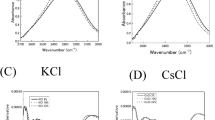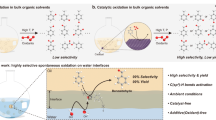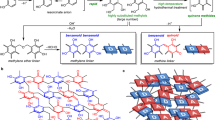Abstract
THE infra-red spectrum of acetylene prepared from calcium carbide and 93 per cent heavy water has been examined photographically up to 12,000 A. with a 4 m. absorbing length at 2 atmospheres1. Four bands have been observed, all of which belong to C2HD as indicated by the absence of alternating intensities. In spite of the high concentration of the heavy water used, no bands due to C2D2 have been observed in this region.
This is a preview of subscription content, access via your institution
Access options
Subscribe to this journal
Receive 51 print issues and online access
$199.00 per year
only $3.90 per issue
Buy this article
- Purchase on SpringerLink
- Instant access to full article PDF
Prices may be subject to local taxes which are calculated during checkout
Similar content being viewed by others
References
H. M. Randall and E. F. Barker (Phys. Rev., 45, 124; 1934) have recently published a short note on the far infra-red spectrum of C2HD and C2D2.
R. Mecke, Z. phys. Chem., B, 17, 1; 1932.
W. Lochte-Holtgreven and E. Eastwood, Z. Phys., 79, 450; 1932.
R. W. Wood, Phys. Rev., 45, 392; 1934.
Author information
Authors and Affiliations
Rights and permissions
About this article
Cite this article
HERZBERG, G., PATAT, F. & SPINKS, J. Bands of ‘Heavy’ Acetylene in the Near Infra-Red. Nature 133, 951 (1934). https://doi.org/10.1038/133951b0
Issue date:
DOI: https://doi.org/10.1038/133951b0
This article is cited by
-
Vibration Spectra and Force Constants of ‘Heavy’ Acetylene
Nature (1934)
-
Das schwere Wasserstoffisotop
Die Naturwissenschaften (1934)



